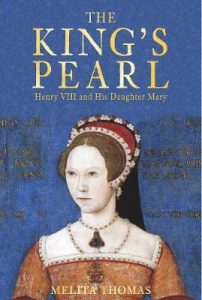 England’s first crowned queen has been in the shadow of England’s second crowned queen for centuries. Just as Elizabeth supplanted Mary as heir to the throne in life, so she has supplanted her in posterity, with Gloriana, the Virgin Queen, heroine who defied the Armada attracting far more praise and admiration than the cruel caricature of Bloody Mary.
England’s first crowned queen has been in the shadow of England’s second crowned queen for centuries. Just as Elizabeth supplanted Mary as heir to the throne in life, so she has supplanted her in posterity, with Gloriana, the Virgin Queen, heroine who defied the Armada attracting far more praise and admiration than the cruel caricature of Bloody Mary.
In her preface to ‘The King’s Pearl’, Melita Thomas sets out her aim to interrogate the stereotype of Mary Tudor as “an unskilled political novice, hesitant and timid until religious mania and her devotion to a heartless, Spanish husband turned her almost overnight into a bloody tyrant”. She does this by exploring the relationship between Mary and Henry VIII in all its fluctuating, tumultuous developments. It’s an interesting angle to take – Thomas makes it clear she doesn’t want to write about the other, more recent stereotype, “Tragic Mary”, delving into her reproductive traumas and marital neglect. Instead, she examines Mary through the lens of her father’s reign and how Henry’s actions impacted the girl who had once been his unrivalled heir.
‘The King’s Pearl’ has been impeccably researched and the intricacies Thomas reveals about Mary’s wardrobe, household and daily life are fascinating. On occasion, this wealth of detail does lead to a slight lapse in narrative drive in the early chapters dealing with Mary’s childhood, but by the time Henry’s Great Matter starts affecting Mary and she becomes more dynamic herself, this is no longer the case and the book’s pace picks up.
Mary emerges as a far bolder, livelier figure than the dour, embittered woman so often depicted in fiction and film. Thomas shows her as a stylish young woman, a skilled musician and an enthusiastic sportswoman; at one point during Anne Boleyn’s reign, Mary even plotted an escape that would see a staged abduction while she was out hunting – not so much the tragically forsaken wife and daughter as a precursor to the powerful leader who would sweep aside John Dudley and Jane Grey to seize the throne that was rightfully hers. As Thomas argues, “Mary, far from being the timid, indecisive figure of many biographies, with no interests beyond her prayers, showed her true nature in her pastimes. She was vigorous and sociable – hunting, dancing, enjoying the entertainment provided by her tumbler and her fool. She dressed magnificently, tipped generously and wagered extravagantly.” It’s a portrayal that frees Mary from the dull stereotypes and I couldn’t help but note that Mary sounds rather similar to many descriptions of Elizabeth, making me wonder what might have been, had the sisters realised they had so much in common.
What might have been is a recurring theme in ‘The King’s Pearl’ – Thomas explores a myriad of betrothals that came to nothing during Henry’s reign, including Mary’s cousin Charles, the Holy Roman Emperor, King Francois of France and several of his sons. One of these, Thomas observes, was rejected by Henry because the terms were deemed insulting: “Henry responded that he loved his daughter well, but he loved himself and his honour more. Perhaps one occasion when Henry truly knew himself!” Asides like this enliven the book and even figures we thought we knew so well are brought to life in new ways.
Overall, this is a fascinating depiction of a relationship that ought to have received greater attention. Henry is not just the notorious serial bridegroom, but a father – often a terrible, cruel, selfish one, and yet, as Thomas points out, “Mary is the only person that Henry ever seems to have forgiven for openly defying him.” Thomas More was executed for such defiance, but Mary escaped the axe, unlike two of her stepmothers, some of many facts which make one question whether she would have been described as ‘Bloody’ had she been a man. Mary emerges here as a survivor, a woman who was loyal, steadfast and passionate: a worthy figure to be England’s first female ruler.
By Naomi Kelsey
Melita Thomas is the co-founder and editor of Tudor Times, a repository of information about Britain in the period 1485-1625 www.tudortimes.co.uk Melita has loved history since being mesmerised by the BBC productions of ‘The Six Wives of Henry VIII’ and ‘Elizabeth R’, when she was a little girl. After that, she read everything she could get her hands on about this most fascinating of dynasties.
Inspired by the courage of the Lady Mary in fighting for her rights in 1553, Melita wanted to explore the truth behind the stereotypes that surround Mary, resulting in ‘The King’s Pearl: Henry VIII and his daughter Mary’.
Connect with Melita:
















She was the first queen but is overshadowed by her sister Elizabeth I.